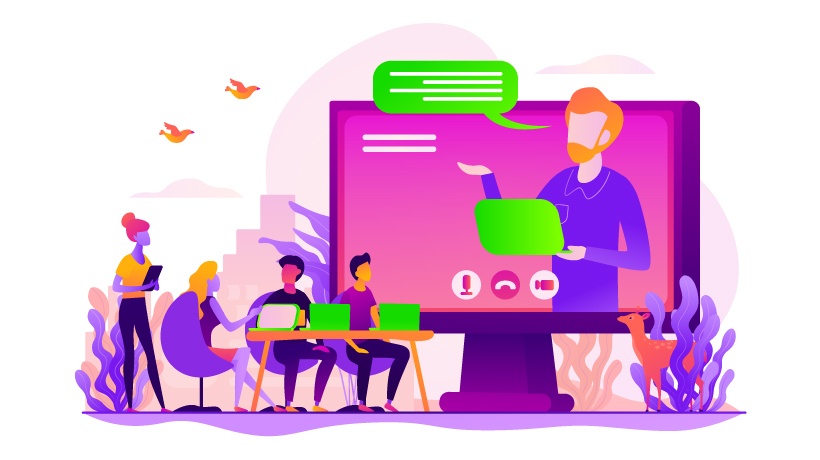Employee Training And Development With eLearning
Now, more than ever, organizations have prioritized eLearning to provide effective, guided training for their remote teams. These EdTech solutions are among the fastest-growing areas in the Learning and Development (L&D) industry and are projected to reach over USD $300 billion by 2025. In 2020, 57% of L&D professionals are expected to spend more time on online learning on a global scale, according to the latest LinkedIn workplace report [1], and this figure is rapidly growing. Companies are increasingly looking for online solutions to be an important link between business growth and employee training and development.
eLearning remains a proven method of digital learning and we’ll talk about what you should be aware of when developing online workplace training so you can provide better and more powerful results for your business in 2020.
When Is An Investment In eLearning Worthwhile For Decision Making Stakeholders?
Think back to the days where companies would send their employees away for weekend seminars or clear out entire workday schedules for classroom training. Online courses and Learning Management Systems have now pushed L&D to the forefront for workplace training priorities. Developing your workforce no longer carries the same risky investment.
The technology itself overcomes many of the past limitations. Online learning now provides constant access, is paced for individual learners, and it adapts to organizational schedules, not the other way around. That resolves typical obstacles such as being too costly, inefficient, time-consuming, impossible to scale, and difficult to measure.
But when do these advantages line up to make an investment worthwhile?
An Overview Of The Importance Of eLearning For Employee Training And Development
We know self-paced digital learning is extremely flexible and can be adjusted and updated to meet changing skill requirements. It’s scalable and easy to provide training in a standardized system across large organizations. It’s essential for training a remote workforce. Plus we’ve seen a move in this direction result in reduced learning time and costs for companies.
With eLearning, organizations are able to accommodate their workforce in their increasing request for “opportunities to learn and grow” [2] far more easily than with traditional methods.
What’s more, you can scale employee development while delivering direct and personalized training throughout your organization. This gives the organization a chance to receive individual feedback about the wellbeing and performance of all employees at a cost that’s far less than training exclusively at brick-and-mortar schools or Instructor-Led classes.
These low barriers for use show that eLearning could be the key to bridge the gap between main business goals and workforce satisfaction and performance. This is especially advantageous because online solutions match the need for overall training, which is emphasized according to a PWC survey [3]. In the report, 79% of CEOs worldwide are concerned that a lack of essential skills in their employees may negatively impact future growth. The LinkedIn workplace report [4] had similar findings. Because of this, digital solutions are increasingly a priority for businesses.
Does That Mean eLearning Has Turned Into A Vital Priority For Organizations?
Well, according to LinkedIn’s report [1] only 27% of L&D professionals report that their CEOs actively get behind learning across their organization even though they spend 20% more time learning soft skills themselves compared to their employees.
While a lack of training and retraining is seen as a major challenge overall and the focus on eLearning is expected to grow even larger in the future, there’s still a gap in getting complete executive support in the implementation of eLearning programs today.
This means the challenge of securing buy-in for a digital learning solution is likely still a major obstacle.
Often It’s About Whether eLearning Provides Unique Solutions For Business Growth
How often have you seen a manager who believes they can slap a PowerPoint together and deliver sufficient training?
(no comment)
It’s difficult when you’re managing talent development because you care about creating quality learning solutions. However, the conversation needs to be one step above the trenches of learning.
For example, marketers often talk about meeting the customer where they are. The same can be true in L&D. If decision-makers are concerned with company growth, they don’t want to hear about how a training program is structured and what technology it uses. Instead, they want to hear how the eLearning program is connected to revenue or other variables for future growth. With this business perspective, you’re more likely to get a seat at the decision table.
Based on that, we need to bridge the gap in measuring performance.
And That Easily Turns Into A Clash Of Hard Goals Vs. Soft Skills
The conversation about justifying training often leads to questions around soft skills and hard business goals—so how do we prove our worth?
Measuring a hard goal, like an increase in sales or cutting production cost and time, etc., is fairly straight forward and desirable for deciding stakeholders. But when it comes to soft-skill development through eLearning, that equation gets much more complicated.
We know that great communication, inspiring team members, and improved decision making are all things that make for better and more fulfilled employees—and therefore better business. Yet how do we put a number on it? And are they part of those essential skills that CEOs around the world see as important for future growth?
The challenge is that a Return on Investment (ROI) in soft skills usually takes a longer time to show results. So, while CEOs see value in developing soft skills of their own, they don’t necessarily see the same value for employees.
In an article from the Association for Talent Development (ATD), it’s argued that throwing L&D professionals into ROI calculations doesn't make sense because it could set themselves and their training program up for failure due to greater scrutiny.
With that said, the answer to when investment in eLearning is worthwhile for all stakeholders lies in this process of discovering what’s expected from a given training program and how it’s evaluated before jumping into an online training course.
This point is clearly highlighted by L&D’s experience in Verizon [1] where they say, "Getting to clearly defined goals before creating an eLearning program makes it much easier to measure the impact after it’s implemented.”
If we look at the LinkedIn workplace report [4], it’s not surprising that the most important, strategic focus area for 2020 has been stated as measuring the effectiveness/impact of learning programs, especially in Canada.
From the same report the most common ways to measure training are:
- Qualitative feedback from employees (43%)
- Course completion (38%)
- Employee satisfaction (34%)
While these are common, they are not necessarily the best way to evaluate, as these are in the realm of softer or "secondary" goals. It shows that L&D has a challenge when it comes to presenting what an eLearning program delivers for the company.
Employee performance or retention may be a better approach when establishing digital learning as a business priority. Unfortunately, there’s seemingly no great industry standard to measure and evaluate performance.
While we can spend time arguing how all these "softer measurements" improve revenue and business growth down the road, it makes little sense if we can’t present how to clearly measure performance.
Decision-makers need this knowledge to determine if an eLearning investment is worthwhile. This information is beneficial for both the employee and the organization as it provides a solid outset to show real value in an eLearning program after implementation.
Are You Developing eLearning That Will Resonate With Employees?
After key decision-makers around the table are on board with a training budget, that’s when we face the next challenge of creating a program that actually works.
While online courses by default have a simple infrastructure to assign flexible learning hours and progress tracking, it can quickly turn into a bundle of content sitting on the company’s internal network collecting digital dust.
The problem is without a sharp insight into those who receive the learning, you risk creating courses that are:
- Irrelevant to the learner(s)
- Possibly outdated compared to their skillset and the challenges they face
- Or worse, they don’t seek out learning on their own because it’s boring
It goes without saying that if you want to position eLearning as a significant influence on business outcomes, then you want that training to be looked forward to, appreciated, and encouraged throughout your organization.
What Matters For The Learner Receiving The Training?
To create new learning that resonates with the learner, customized solutions are foundational to the most effective form of eLearning. Do you know about their daily functions? What courses have they taken in the past? What are their ambitions within the organization?
In marketing, there are often references to a “target market” as opposed to a “mass market.” The foundation of eLearning is that it will be more effective if it is focused on a group of specific people you can develop, present and deliver a better product or service to than if you’re trying to accommodate everyone.
The idea is similar when developing online courses for specific teams or departments in an organization. I previously wrote about this process of developing a learner persona to get more effective learning solutions. Relevant learning is essential for employees.
For example, almost all employees surveyed in LinkedIn’s 2019 workplace report [4] (94%) “would stay at a company longer if it invested in their Learning and Development.”
According to the same report, most professionals want training to fit their specific roles and needs and be provided at the right time. Most seemingly, many want to learn while in a social setting. So we can assume that developing customized eLearning plays a big role in keeping and attracting the best talent.
According to Gallup [2], only one-third of millennials strongly agree that their most recent learning opportunity at work was “well worth” their time. This suggests that most eLearning programs fall short on one of their biggest value propositions—employee retention. It’s not surprising that all of us want to improve our skills and knowledge to improve ways of working. The point is that this speaks for a digital learning culture.
When corporate eLearning is taken to a higher level, learning becomes a central part of growing the company.
For example, Google has made a point of creating a learning culture with a training network that includes employee-to-employee or Googler-to-Googler (g2g). With over 6000 employees in a volunteer teaching network, there are ample opportunities, from teaching courses to 1:1 mentoring. There’s even continuous addition to the design of learning materials where there’s input coming from every department of the company.
While this is something that has taken years for Google to achieve, they attribute investing in training programs and creating a culture of learning as a foundation for improving their entire organization.
Conquering Learner Engagement And Interaction To Succeed On Performance Objectives
What makes a difference in online training for employees often boils down to one of the crucial challenges in successful eLearning—learner engagement. Think about any online training course you’ve ever taken that seemed misplaced. Perhaps there was no connection with your current skill level or it lacked clear steps on how to apply what you learned. Or, maybe you needed more support and inspiration in order to complete it successfully.
Of course, there can be different reasons why a learner doesn’t absorb the material in an eLearning course, but engagement is a big one, and it’s one we have influence over. When driving engagement, there are two interesting factors that can push eLearning forward:
- Creating a stronger learning culture by getting executives to champion learning
- Looking at the data employees provide
Getting executives behind the development of training and learning programs inspires more engagement because it’s more likely to connect to business goals and thus, be relevant for the learner. This means that creating a successful eLearning program starts by getting full support from top decision-makers.
Following a PWC report [3] that surveyed CEOs worldwide, it was found that “Workers need to be engaged…and that only happens if a strong learning culture is woven into a high-quality workplace.”
If we look at the g2g network from Google mentioned earlier, it also shows that online learning (even when it’s personalized) doesn’t cover the full aspect of what matters to learners. Accountability through fellow colleagues is an important factor in making sure the training program is implemented and doesn’t slide from memory. Pairing self-paced learning with an accountability strategy arguably also encourages an environment of wanting to improve yourself and the company.
If you think about the last time you took an online course, it’s one thing going through all the modules on your own time—noting new techniques, approaches, or systems. It’s another thing entirely to actually put all that new information to practical use. According to LinkedIn, almost half of employees say they don’t have time to learn at work (49%), while 83% of online learning happens during the workweek. If that’s the case, then creating online courses that are not only retained on a learning level but also engage employees enough to stick with the company is a major challenge.
Not surprisingly, the same report shows that 24% of L&D professionals on a global scale don’t even measure engagement at all based on their online data. As the report goes on to say, this indicates that there’s a major challenge for eLearning here.
To make matters worse, some data may not even be great signs of learner engagement. For example, what good is a high course completion if there’s no follow-up to see how well it was implemented? Does the amount of “time spent learning” each month automatically mean the same as “time spent applying” what was learned?
This seems to sync up pretty well with the top 3 global challenges for talent developers, according to the LinkedIn report:
- Getting managers to put learning as a priority for their teams (49%)
- Creating a learner culture (42%)
- Increasing employee engagement (36%)
Discovering When eLearning Is Not The Right Solution And What To Do Instead
Even though eLearning is stealing the spotlight from Instructor-Led training, your needs analysis is crucial in uncovering whether digital training is going to have the desired impact.
Here are a few examples of questions to uncover if eLearning is the right way to go:
- Does it build on top of pre-existing skills or knowledge?
- How urgent is it?
- How many people are going to take the course?
- How often does it need to be updated to keep relevance?
- How do we make sure it’s implemented?
As we covered, eLearning is a great way to provide scalable learning, but you should consider if a team or employee would benefit more from an eLearning solution compared to other training solutions. For example, if the nature of the training is so specific and narrow that you wouldn’t be able to reuse the same online course for other team members or employees, then options like Instructor-Led classes, coaching, or live courses may be a better fit.
You should also consider whether using job aids and training from SMEs would accomplish the same result when challenges are more practical and require hands-on experience. It’s also important to discover if the business problems you’re trying to solve are something that even comes from a lack of training.
There could be an underlying problem in the structure of the company, dysfunctional teams, bad leadership, or an external factor, such as market changes, that have a negative impact on certain industries.
A lot of the needs analysis comes back to how eLearning will provide better business performance.
Find Out If eLearning Fits Your Employee Training And Development Today
Given everything we covered above, it’s clear that building the right training and development program for your employees isn’t something you can slap together in a single afternoon. We know that the first major challenge is matching eLearning solutions clearly to business problems, and it’s arguably as important as developing the content itself.
Lastly, engagement remains something that can’t be championed by eLearning content alone and may require Instructor-Led assistance. This is especially true when looking at the use of any given online course being transferred to daily practice in the workforce. But, eLearning can play a vital role in larger business impacts, keeping and developing the best talent.
References:
[1] 2020 Workplace Learning Report
[2] Millennials Want Jobs to Be Development Opportunities
[4] 4th Annual 2020 Workplace Learning Report









